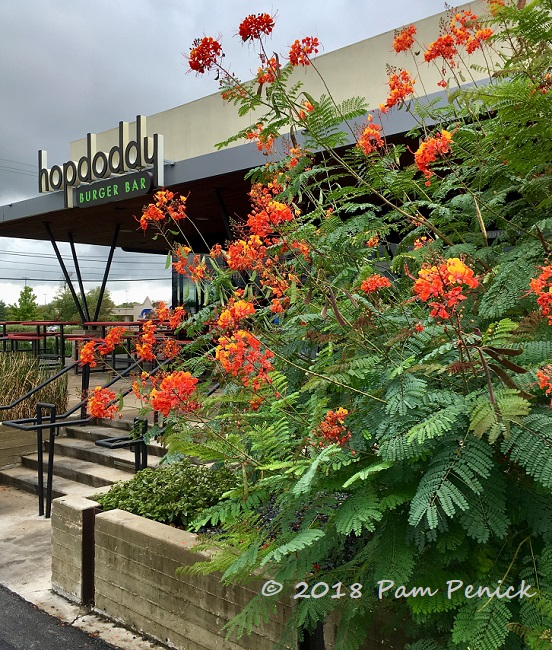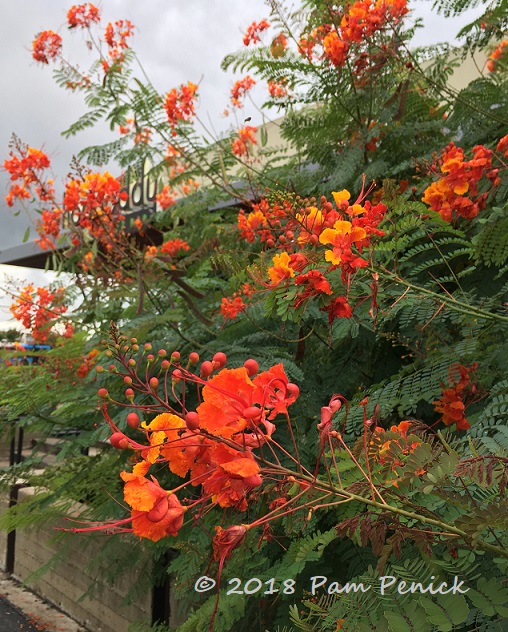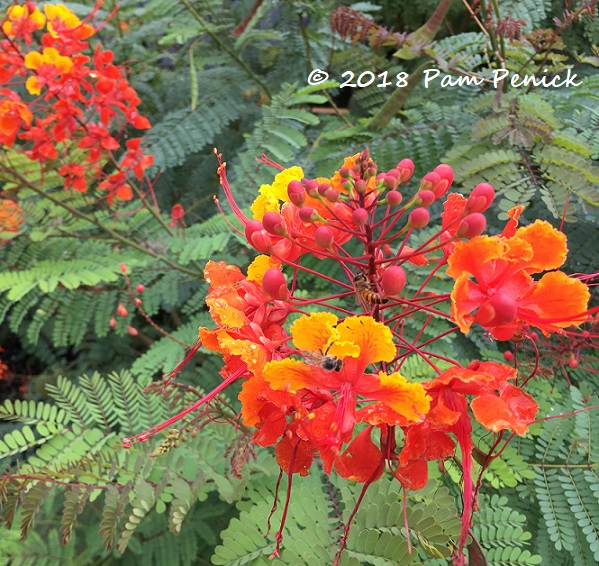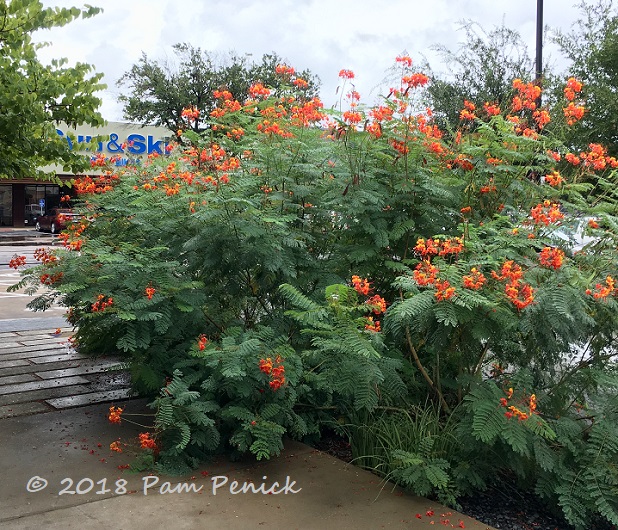Plant This: Pride of Barbados, Caesalpinia pulcherrima
When summer’s heat sizzles the back of your neck and it hasn’t rained in a month and the rest of your plants want to give up, Pride of Barbados (Caesalpinia pulcherrima) sassily unfurls dozens of ruffled, ember-hued flowers at the ends of blue-green, feathery-leaved branches and throws a party. Those heat-defying blooms just keep coming all the way through October. This is a plant you want on your side in Texas.
I’ve never grown it myself (not enough sun), but every year I admire it in gardens and commercial landscapes all over Austin. This year Pride of Barbados was particularly outstanding, its exotic-looking flowers blazing beautifully through the end of our long, hot summer. I spotted this enormous specimen at Hopdoddy’s on Anderson Lane, blooming in 100-degree weather next to a heat-radiating parking lot. What a performer, if you have the space and the sun!
Crepe-paper-textured flowers attract bees, hummingbirds, and butterflies such as tiger swallowtails, but deer totally ignore it, at least in my neighborhood. Winter freezes kill it to the ground, but it comes back reliably in late spring, achieving a rangy height and width of 5 to 8 feet by summer’s end. It needs full sun and good drainage but little supplemental irrigation. Just give it plenty of room to spread out. Also it tends to be thorny inside the feathery branches, so wear gloves when pruning it.
Its orange-and-gold flowers and fine-textured leaves look especially pretty behind beefy, silver-blue agaves like A. americana or whale’s tongue. Hate orange? There’s a yellow variety called yellow bird of paradise (Caesalpinia gilliesii), which is almost as pretty.
Plant Pride of Barbados and take pride in your garden’s summer show.
Note: My Plant This posts are written primarily for gardeners in central Texas. The plants I recommend are ones I’ve grown myself and have direct experience with. I wish I could provide more information about how these plants might perform in other parts of the country, but gardening knowledge is local. Check your local online gardening forums to see if a particular plant might work in your region.
I welcome your comments; please scroll to the end of this post to leave one. If you’re reading this in a subscription email, click here to visit Digging and find the comment box at the end of each post.
_______________________
Digging Deeper: News and Upcoming Events
Join the mailing list for Garden Spark Talks! Inspired by the idea of house concerts, I’m hosting a series of garden talks by inspiring designers and authors out of my home. Talks are limited-attendance events and generally sell out within just a few days, so join the Garden Spark email list for early notifications. Simply click this link and ask to be added.
All material © 2006-2018 by Pam Penick for Digging. Unauthorized reproduction prohibited.






What a plant. It is a fooler because to me those tiny leaves and those big flowers look so delicate.
They do, but this plant is Texas tough.
After several freezes, I keep mine in pots and they doing extremely well.
It can also, of course, be grown as an annual where winters are too cold.
These plants are so beautiful. I purchased one as a tiny 8″ plant at the local Master Gardeners’ sale two springs ago. I didn’t think it would grow in east Texas so I was surprised to see it. I decided to try it anyway. It was the only one of its kind at the sale.–I believe it was homegrown. Last winter, we got down to 9 degrees in my backyard, and I was sure it was a goner. Spring came and I didn’t see it, but then *boom* there it was. It hasn’t bloomed, but I’m pleased it survived. It’s only about 30″ tall. I did, however, mulch it well last winter.
Wow, that’s a remarkable winter survival story for this plant, Laura. I’m sure your mulch helped it survive, so well done!
Oh how I wish I could grow this plant! My brother in Phoenix grows it so I admire it there everytime I visit.
I bet it loves that Phoenix heat.
Hmmm… I think your blog just ate my comment?
Sorry for the confusion, Loree. I’m now moderating all comments in order to combat spam. I need to see if I can put that in the “thanks for commenting” message so people don’t wonder what happened.
I agree this is a fabulous plant for our summer gardens. It allows the spring bloomers to leave before it ever raises its head. It grows easily from seeds that fall onto the ground as I am finding out. Mine has been visited constantly by butterflies and humming birds this summer.
That’s the best part, perhaps. And it’s good to know that it grows easily from seed, especially in a gravelly garden like yours.
This looks like bird of paradise – am I crazy?
I believe that’s another common name for it, Deb. So no, not crazy!
Such a beautiful plant – Oh to have space, sun, and enough heat to grow it in my garden.
Careful what you wish for, Peter — haha!
Here too, Pam. I think it’s about done flowering around town now, which is where I admire it. Because it’s a big and blowsy late bloomer, I always find it awkward to fit into my garden. And then I always rethink that judgment when it’s in bloom 😉
It IS big, and I bet it’s even bigger in L.A., where presumably it doesn’t die back to the ground every winter?
Hi Pam: Thank you for highlighting this beautiful plant; it brings back such fond memories. My Mom and I had several of these growing in our Palm Desert garden and I sure miss those beautiful flowers and that airy foliage. On occasion after a real cold snap, the plant would look like a goner but re-emerge faithfully with a little pruning. Sure wish I could grow it in N. Carolina. In Palm Desert they called it Mexican Bird of Paradise.
Thanks for sharing your experience of growing it in the desert, Marilyn. Here in Austin we call the yellow-flowered variety Bird of Paradise, while the orange is Pride of Barbados or poinciana.
They just planted these up and down Great Northern which is parallel to the train tracks. This will be beautiful when they get big and bloom!
That’ll be pretty!
A little late to add to the conversation, but there are actually three fairly common species of Caesalpinia that I have seen here in Austin — C. gilliessii and C. mexicana can be found in addition to the featured Caesalpinia pulcherrima (which exists in 3 different color morphs — Orange, pink (subspecies rosea), and and solid yellow (lutea) of which I have only seen the orange locally.) C.g. differs from the yellow morph of Pride of Barbados in having more delicate, airy glaucus foliage, and red anthers in the flowers. It is arguably more drought and cold tolerant. The Mexican species also has yellow flowers, but is somewhat coarser looking, and typically grows to a small winter-tender tree, though, like its cousin, it typically returns after a freeze.
Thanks for the info, Philip. I had no idea there were so many different types.
Could you tell me something about the root structure of the Pride of Barbados plant? How deep they get and how spread out they run. I have one planted about 5 feet from our pool. Should I move it? It is beautiful.
I don’t know how far out the roots run. Considering its drought tolerance, I imagine they go deep instead. And it’s not a tree, so I think 5 feet sounds like a reasonable distance from your pool. Enjoy!